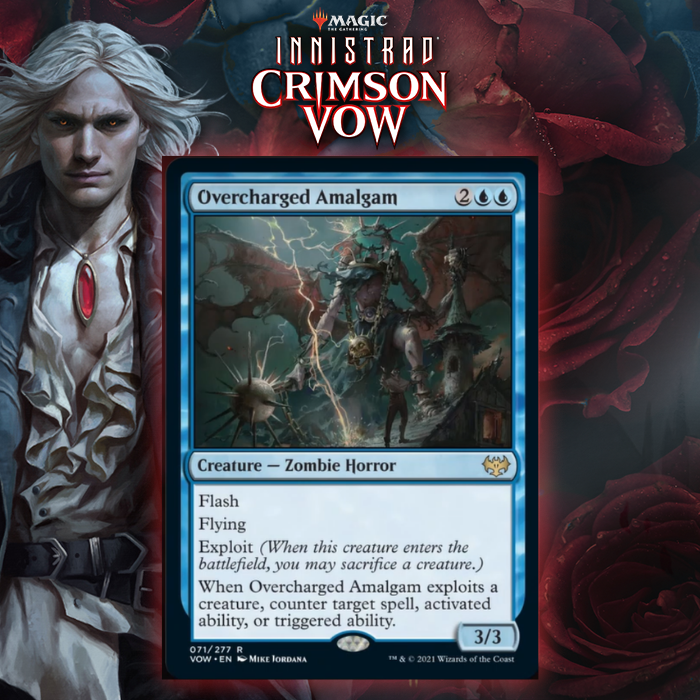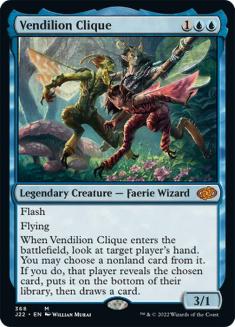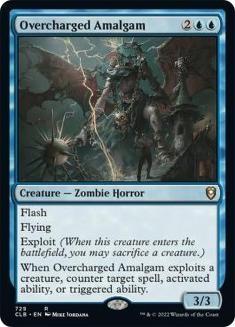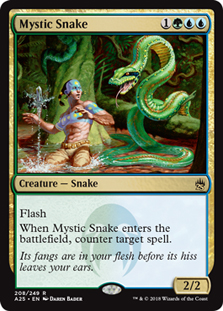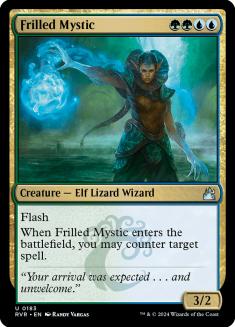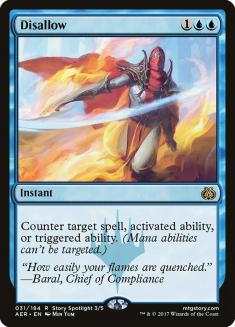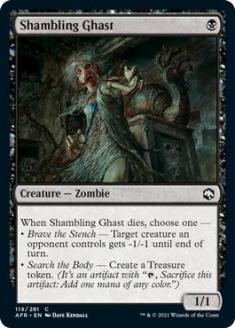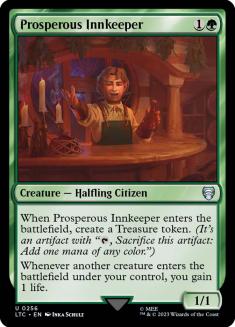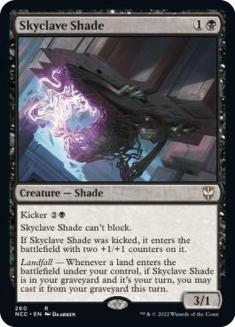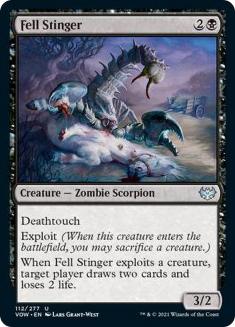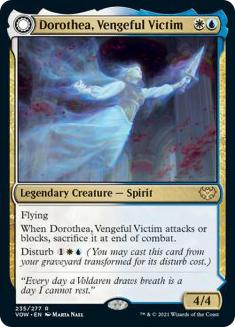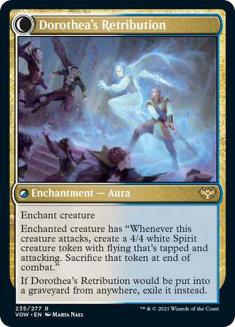A common theme in my preview articles is that I like flexible cards. I’m a huge fan of choices and trade-offs, because I believe they make for interesting and varied game states.
If you have a three-drop, everyone casts it on Turn 3. If you have a three-drop that has kicker 2, some people will cast it on Turn 3, and some people will cast it on Turn 5; you yourself will cast it on Turn 3 some of the time and on Turn 5 some of the time, and I think that’s interesting.
It’s because of this that Vendilion Clique is my favorite card of all time. You can cast it at any moment because it has flash (your turn, their turn, draw step, upkeep, combat, end of turn, etc.). You can target yourself or your opponent, and finally you can choose to take a card from them or not. So, with this one card, you get many possible play patterns and many choices.
Overcharged Amalgam is one such card. It looks like one thing, but it’s actually many things at once.
We’ve seen this type of effect before in cards like Mystic Snake and Frilled Mystic, so the design is not entirely novel, but both these cards saw ample amounts of play, and Overcharged Amalgam is different in some spots.
First, it’s strictly a blue card, which is obviously a bonus, and second it’s actually a meaningful creature, much more so than its predecessors. This means that it’s better at having a “second mode” than these cards were, because a 3/3 flyer is actually a meaningful body, which opens up a lot more possibilities for it. If they do nothing and you cast Frilled Mystic at the end of the turn, you’re getting a pretty bad deal, but if you cast Overcharged Amalgam, things go much better for you.
Previously, if you attacked with your 2/2, I couldn’t ambush it with Frilled Mystic; it was relegated to ambushing only one-power attackers, which are few and far between on Turn 4. As a 3/3 flyer, the range of things Overcharged Amalgam kills in combat is much higher, and if this card sees any play (which I’m thinking / hoping it will), it might change how we approach the game from Turn 4 onwards in a similar way that Cryptic Command and Mistbind Clique did.
The thing I like the most about this card is that it offers a Catch-22. Normally, if you’re worried about counterspells, what you do is attack. If you’re worried about combat tricks, what you do is cast spells. This card will punish you either way – either your 2/2 is getting eaten for free or your spell is getting countered. If you try to do the sensible thing and just pass the turn, then you just got Time Walked because they get to deploy their threat anyway!
Overcharged Amalgam also has some other particularities in that it can counter activated and triggered abilities as well. This is not a common effect in Magic, and it can be particularly devastating when added to a card for free. For example, you didn’t play Disallow so that you could counter abilities, but any time you countered a Chandra, Torch of Defiance Ultimate with it, it felt incredible.
Adding this line of text to a card you’d already normally play opens up a lot of tricky play sequences that your opponent is unlikely to consider. Even if they know Overcharged Amalgam can see play, it can be very hard to remember to play around it with your triggers because people messing with your triggers happens so infrequently. For example, when we animate Esika’s Chariot, or activate Faceless Haven, or use Sculptor of Winter, or have our Brutal Cathar transform back into a Human, we usually don’t consider that these can just be stopped. With Overcharged Amalgam, they can.
The downside of Overcharged Amalgam, of course, is that you have to sacrifice a creature if you want it to counter something (though not if you just want to cast it as a threat or to ambush something). This will range from a minor inconvenience to an impossibility most of the time, but there will be rare occasions in which it’s actually a bonus (such as needing to sacrifice a Shambling Ghast). Regardless, this means it’s not a card you can just throw into a deck. For example, it would not have been very good in the Simic Flash deck that played Frilled Mystic because that deck just didn’t have any spare creatures. If you can support it and make the cost not too big, however, I think it’s definitely going to be worth it.
It’s also worth noting that, much like any exploit creature, it can sacrifice itself. This makes it so that it’s, at worst. a four-mana Disallow or 3/3 flash flying split card, and at best something you can combo with recursion to counter everything your opponent plays. As a creature, it’s also immune to Negate; Test of Talents; and Thalia, Guardian of Thraben or Reidane, God of the Worthy taxes the way a four-mana Disallow would be, though it is vulnerable to creature removal if they kill it in response to the trigger.
Even though we can sacrifice Overarcharged Amagam to itself, we’d usually rather sacrifice something worse, so what are the creatures we don’t mind sacrificing? The first thing that comes to mind is Decayed tokens, of course — if we can produce some of those, then all our sacrifice needs are dealt with until the rest of the game. Barring that, we can also sacrifice creatures with leaves-the-battlefield abilities (Eyetwitch, Shambling Ghast); creatures with enters-the-battlefield abilities that have already triggered (Prosperous Innkeeper, Acquisitions Expert, Elderfang Disciple); cheap recurring or disturb creatures (Skyclave Shade, Lunarch Veteran); redundant legendaries (Kalain, Reclusive Painter; Jadar, Ghoulcaller of Nephalia); or just tokens in general.
A natural shell for the deck is Dimir, given how good the black cards are at producing relatively expendable bodies, and one potential build of that is Dimir Zombies. Dimir Zombies is a deck that never really took off, but one that I have some hopes for with Innistrad: Crimson Vow, and it seems perfect for Overcharmed Amalgam. It’s an aggro deck, so it can make use of the 3/3 flyer body. It has ample bodies to sacrifice, and it even has Zombie synergies, which Overcharged Amalgam happens to be.
The set is still very new, but there’s already another Zombie that interests me — Fell Stinger. If you’re already into sacrificing creatures, it’s a 3/2 Zombie with deathtouch that draws two cards when it enters the battlefield that can also act as a finisher to deal the last two points of damage.
Here’s how a list might look:
Creatures (29)
- 4 Shambling Ghast
- 4 Champion of the Perished
- 4 Jadar, Ghoulcaller of Nephalia
- 4 Bladestitched Skaab
- 2 Graveyard Trespasser
- 4 Tainted Adversary
- 4 Overcharged Amalgam
- 3 Fell Stinger
Lands (21)
Spells (10)

Alternatively, this can also see play in Azorius Flyers, a very similar deck to what Noriyuki Mori played at Magic World Championship XXVII. That deck will not have nearly as many convenient cards to sacrifice, but it might make even better use of the 3/3 flying body and the Counterspell effect. A lot of the time, these Azorius decks aggro you out and the opponent only has time to cast one big spell — a sweeper or an Alrund’s Epiphany — so being able to counter that is just game over even if you have to sacrifice a more regular creature. Besides that, this deck has an overall higher number of instant-speed spells, so you now add something else that you’re representing, and it even has the combo with Fading Hope to bounce itself and counter something else down the line.
One card that could see play here as well is Dorothea, Vengeful Victim.
Dorothea is a reasonable card to sacrifice (it’s gonna die anyway, though you do miss out on four damage unless their timing is really weird), and then it can be a reasonable aggressive card once it’s in the graveyard, given how many flyers you have. It’s also a great blocker, if you’re into that. This card is extremely hard for me to evaluate given that it’s so different from anything we’ve ever had, but I think this might be the archetype for it and I want to try it, and I have an inkling it might end up being a pretty good card in this format.
Here’s how I would build the deck:
Creatures (29)
- 4 Luminarch Aspirant
- 4 Usher of the Fallen
- 2 Reidane, God of the Worthy
- 4 Elite Spellbinder
- 1 Brutal Cathar
- 4 Spectral Adversary
- 3 Intrepid Adversary
- 2 Malevolent Hermit
- 3 Overcharged Amalgam
- 2 Dorothea, Vengeful Victim
Lands (25)
Spells (6)

Noriyuki Mori didn’t play any Usher of the Fallen, but I think that it’s just a good card, especially with Luminarch Aspirant in your deck, and the fact that it makes tokens that you can then sacrifice to Overcharged Amalgam is icing on the cake, so I chose to include it.
In the end, it’s impossible to know if Overcharged Amalgam is going to be great — I think it’s good, but it’s so hard to know how the metagame will turn out — but it’s certainly the kind of card that, if it does end up being good, might warp the metagame around it. A couple of months from now, given the right development, we could be thinking, “What can I do if they have Overcharged Amalgam?” every turn of the game past Turn 4, the same way we did for Cryptic Command or Mistbind Clique back when those were Standard staples.

